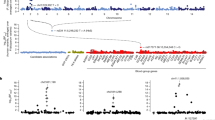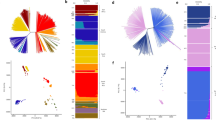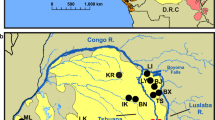Abstract
Complement receptor 1 (CR1) levels have been associated with malarial susceptibility and/or severity of the disease in different population groups, and CR1 is a receptor for Plasmodium falciparum. In this study, multiple CR1 single-nucleotide polymorphisms (SNPs) showed strong evidence of population differentiation between Sardinian and other European ethnic groups. Cross population algorithms comparing haplotype structure and differences in haplotype and allele frequency distribution provided additional support for natural selection of CR1 in Sardinia. The predominant Sardinian CR1 haplotype included SNPs that are associated with decreased CR1 levels in Europeans and other population groups. Previous studies have shown that the SNPs within the dominant Sardinian haplotype have a significantly higher frequency in a malaria endemic compared with non-endemic regions in India. Together with the historical evidence of the prevalence of malaria in Sardinia, these data support the role of malaria leading to positive selection of this CR1 haplotype in Sardinia.
This is a preview of subscription content, access via your institution
Access options
Subscribe to this journal
Receive 6 digital issues and online access to articles
$119.00 per year
only $19.83 per issue
Buy this article
- Purchase on Springer Link
- Instant access to full article PDF
Prices may be subject to local taxes which are calculated during checkout


Similar content being viewed by others
References
Akey JM, Zhang G, Zhang K, Jin L, Shriver MD . Interrogating a high-density SNP map for signatures of natural selection. Genome Res 2002; 12: 1805–1814.
Sabeti PC, Reich DE, Higgins JM, Levine HZ, Richter DJ, Schaffner SF et al. Detecting recent positive selection in the human genome from haplotype structure. Nature 2002; 419: 832–837.
Voight BF, Kudaravalli S, Wen X, Pritchard JK . A map of recent positive selection in the human genome. PLoS Biol 2006; 4: e72.
Grossman SR, Shylakhter I, Karlsson EK, Byrne EH, Morales S, Frieden G et al. A composite of multiple signals distinguishes causal variants in regions of positive selection. Science 2010; 327: 883–886.
Sabeti PC, Varilly P, Fry B, Lohmueller J, Hostetter E, Cotsapas C et al. Genome-wide detection and characterization of positive selection in human populations. Nature 2007; 449: 913–918.
Bersaglieri T, Sabeti PC, Patterson N, Vanderploeg T, Schaffner SF, Drake JA et al. Genetic signatures of strong recent positive selection at the lactase gene. Am J Hum Genet 2004; 74: 1111–1120.
Sulem P, Gudbjartsson DF, Stacey SN, Helgason A, Rafnar T, Magnusson KP et al. Genetic determinants of hair, eye and skin pigmentation in Europeans. Nat Genet 2007; 39: 1443–1452.
Contu D, Morelli L, Santoni F, Foster JW, Francalacci P, Cucca F . Y-chromosome based evidence for pre-neolithic origin of the genetically homogeneous but diverse Sardinian population: inference for association scans. PLoS One 2008; 3: e1430.
Dyson SL, Rowland Jr RJ . Archaeology and History in Sardinian from the Stone Age to the Middle Ages: Shepherds, Sailors and Conquerors. University of Pennsylvania Press: Philadelphia, 2007.
Vona G . The peopling of Sardinia (Italy): history and effects. Intl J Anthropol 1997; 12: 71–87.
Siniscalco M, Bernini L, Latte B, Motulsky AG . Favism and thalassaemia in Sardinia and their relationship to malaria. Nature 1961; 190: 1179–1180.
Tognotti E . Malaria in Sardinia. Intl J Anthropol 1998; 13: 237–242.
Chen H, Patterson N, Reich D . Population differentiation as a test for selective sweeps. Genome Res 2010; 20: 393–402.
Tham WH, Wilson DW, Lopaticki S, Schmidt CQ, Tetteh-Quarcoo PB, Barlow PN et al. Complement receptor 1 is the host erythrocyte receptor for Plasmodium falciparum PfRh4 invasion ligand. Proc Natl Acad Sci USA 2010; 107: 17327–17332.
Xiang L, Rundles JR, Hamilton DR, Wilson JG . Quantitative alleles of CR1: coding sequence analysis and comparison of haplotypes in two ethnic groups. J Immunol 1999; 163: 4939–4945.
Wilson JG, Murphy EE, Wong WW, Klickstein LB, Weis JH, Fearon DT . Identification of a restriction fragment length polymorphism by a CR1 cDNA that correlates with the number of CR1 on erythrocytes. J Exp Med 1986; 164: 50–59.
Rowe JA, Moulds JM, Newbold CI, Miller LH . P. falciparum rosetting mediated by a parasite-variant erythrocyte membrane protein and complement-receptor 1. Nature 1997; 388: 292–295.
Rowe JA, Rogerson SJ, Raza A, Moulds JM, Kazatchkine MD, Marsh K et al. Mapping of the region of complement receptor (CR) 1 required for Plasmodium falciparum rosetting and demonstration of the importance of CR1 in rosetting in field isolates. J Immunol 2000; 165: 6341–6346.
Nagayasu E, Ito M, Akaki M, Nakano Y, Kimura M, Looareesuwan S et al. CR1 density polymorphism on erythrocytes of falciparum malaria patients in Thailand. Am J Trop Med Hyg 2001; 64: 1–5.
Sinha S, Jha GN, Anand P, Qidwai T, Pati SS, Mohanty S et al. CR1 levels and gene polymorphisms exhibit differential association with falciparum malaria in regions of varying disease endemicity. Hum Immunol 2009; 70: 244–250.
Thomas BN, Donvito B, Cockburn I, Fandeur T, Rowe JA, Cohen JH et al. A complement receptor-1 polymorphism with high frequency in malaria endemic regions of Asia but not Africa. Genes Immun 2005; 6: 31–36.
Krych-Goldberg M, Moulds JM, Atkinson JP . Human complement receptor type 1 (CR1) binds to a major malarial adhesin. Trends Mol Med 2002; 8: 531–537.
Cockburn IA, Mackinnon MJ, O’Donnell A, Allen SJ, Moulds JM, Baisor M et al. A human complement receptor 1 polymorphism that reduces Plasmodium falciparum rosetting confers protection against severe malaria. Proc Natl Acad Sci USA 2004; 101: 272–277.
Cockburn IA, Rowe JA . Erythrocyte complement receptor 1 (CR1) expression level is not associated with polymorphisms in the promoter or 3′ untranslated regions of the CR1 gene. Int J Immunogenet 2006; 33: 17–20.
Rowe JA, Raza A, Diallo DA, Baby M, Poudiougo B, Coulibaly D et al. Erythrocyte CR1 expression level does not correlate with a HindIII restriction fragment length polymorphism in Africans; implications for studies on malaria susceptibility. Genes Immun 2002; 3: 497–500.
Zimmerman PA, Fitness J, Moulds JM, McNamara DT, Kasehagen LJ, Rowe JA et al. CR1 knops blood group alleles are not associated with severe malaria in the Gambia. Genes Immun 2003; 4: 368–373.
Herrera AH, Xiang L, Martin SG, Lewis J, Wilson JG . Analysis of complement receptor type 1 (CR1) expression on erythrocytes and of CR1 allelic markers in Caucasian and African American populations. Clin Immunol Immunopathol 1998; 87: 176–183.
Thathy V, Moulds JM, Guyah B, Otieno W, Stoute JA . Complement receptor 1 polymorphisms associated with resistance to severe malaria in Kenya. Malar J 2005; 4: 54.
D’Amore G, Di Marco S, Floris G, Pacciani E, Sanna E . Craniofacial morphometric variation and the biological history of the peopling of Sardinia. Homo 2010; 61: 385–412.
Weir B, Cockerham C . Estimating F-statistics for the analysis of population structure. Evolution 1984; 38: 1358–1370.
Tian C, Kosoy R, Nassir R, Lee A, Villoslada P, Klareskog L et al. European population genetic substructure: further definition of ancestry informative markers for distinguishing among diverse European ethnic groups. Mol Med 2009; 15: 371–383.
Liu X, Invernizzi P, Lu Y, Kosoy R, Lu Y, Bianchi I et al. Genome-wide meta-analyses identify three loci associated with primary biliary cirrhosis. Nat Genet 2010; 42: 658–660.
Howie BN, Donnelly P, Marchini J . A flexible and accurate genotype imputation method for the next generation of genome-wide association studies. PLoS Genet 2009; 5: e1000529.
Acknowledgements
This study was in part supported by the US National Institutes of Health (R01 DK056839, and a grant to HYPERGENES (European Network for Genetic-Epidemiological Studies HEALTH-F4-2007-201550.
Author information
Authors and Affiliations
Corresponding author
Ethics declarations
Competing interests
The authors declare no conflict of interest.
Additional information
Supplementary Information accompanies the paper on Genes and Immunity website
Supplementary information
Rights and permissions
About this article
Cite this article
Kosoy, R., Ransom, M., Chen, H. et al. Evidence for malaria selection of a CR1 haplotype in Sardinia. Genes Immun 12, 582–588 (2011). https://doi.org/10.1038/gene.2011.33
Received:
Revised:
Accepted:
Published:
Issue Date:
DOI: https://doi.org/10.1038/gene.2011.33
Keywords
This article is cited by
-
Complement Receptor 1 availability on red blood cell surface modulates Plasmodium vivax invasion of human reticulocytes
Scientific Reports (2019)
-
Population- and individual-specific regulatory variation in Sardinia
Nature Genetics (2017)
-
The African Genome Variation Project shapes medical genetics in Africa
Nature (2015)



